Financial Analysis and Auditing of Carnarvon Petroleum (2019)
VerifiedAdded on 2022/09/26
|13
|2293
|15
Report
AI Summary
This report analyzes the audit of Carnarvon Petroleum, focusing on the 2019 annual report. It examines the concept of materiality, detailing the levels used by the auditor, Ernst & Young, and its application to Carnarvon Petroleum's financial statements. The report includes a financial statement analysis, measuring profitability, solvency, and efficiency ratios from 2016 to 2019 to assess the company's financial position. It also reviews the cash flow statements, highlighting significant inflows and outflows, particularly in investment activities. The analysis reveals the company's financial challenges, including reduced profit margins and below-average financial leverage, and discusses the auditor's assertions regarding completeness, existence, and valuations. The report concludes by emphasizing the importance of the auditor's role in safeguarding stakeholder interests, given the company's financial performance.
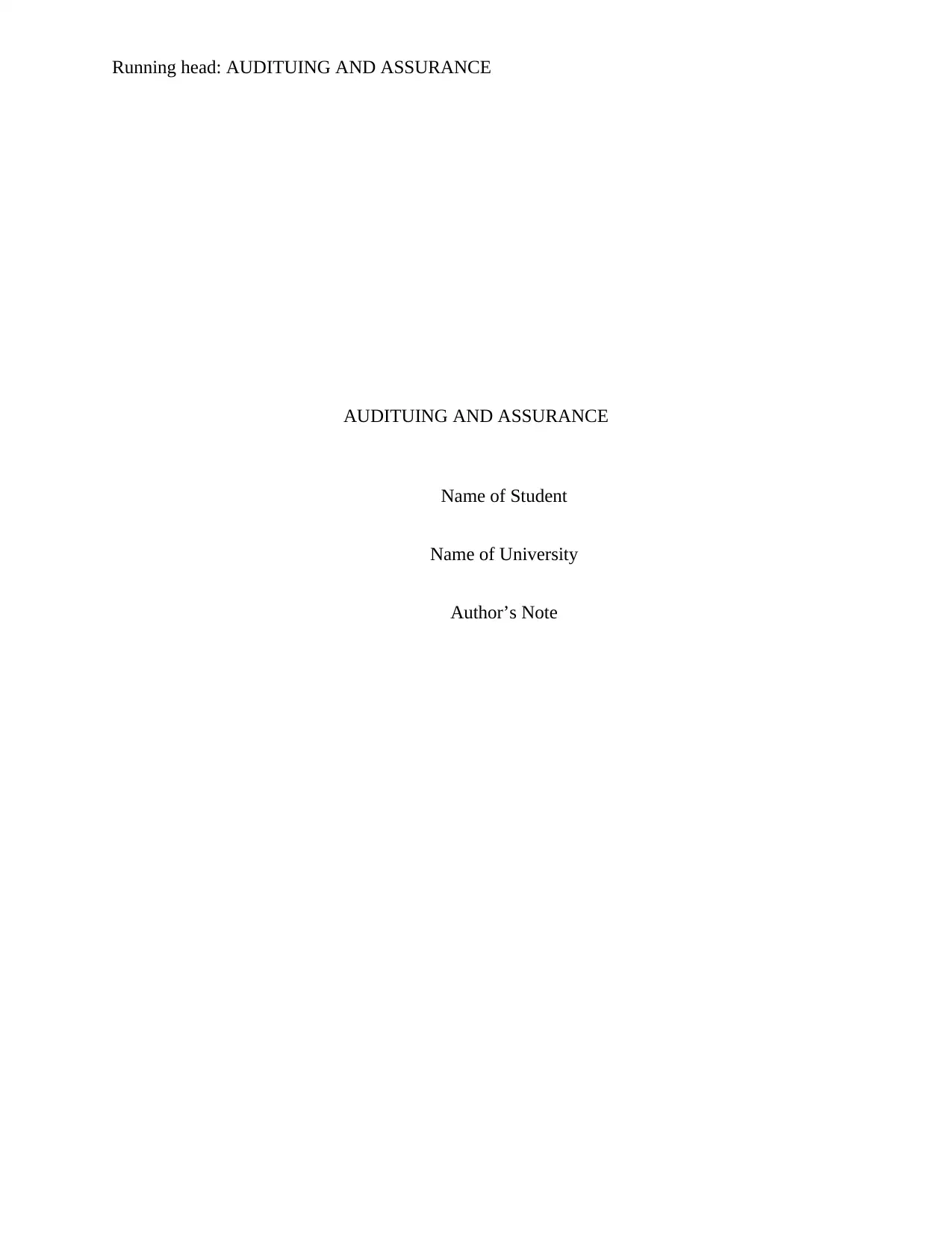
Running head: AUDITUING AND ASSURANCE
AUDITUING AND ASSURANCE
Name of Student
Name of University
Author’s Note
AUDITUING AND ASSURANCE
Name of Student
Name of University
Author’s Note
Paraphrase This Document
Need a fresh take? Get an instant paraphrase of this document with our AI Paraphraser
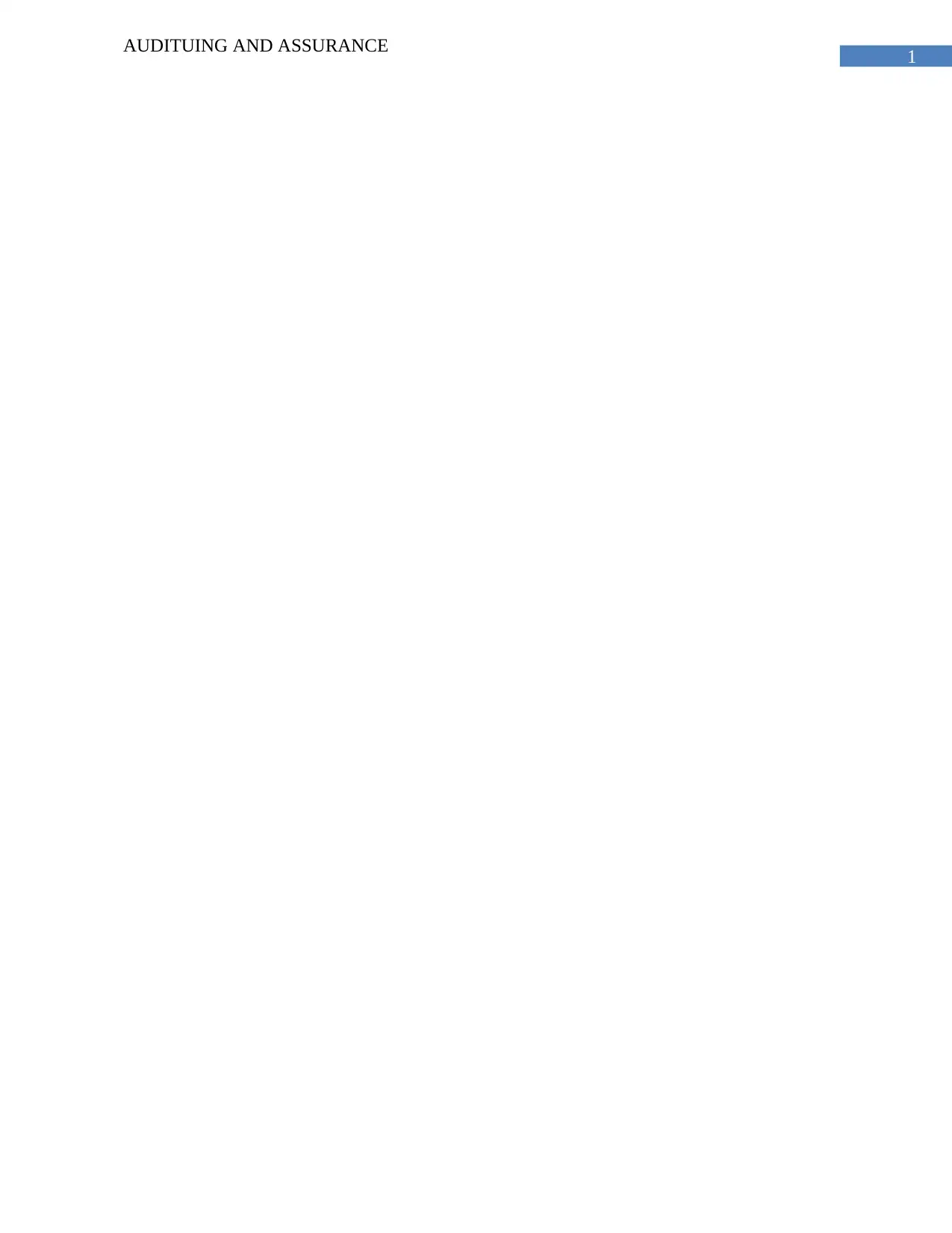
1
AUDITUING AND ASSURANCE
AUDITUING AND ASSURANCE
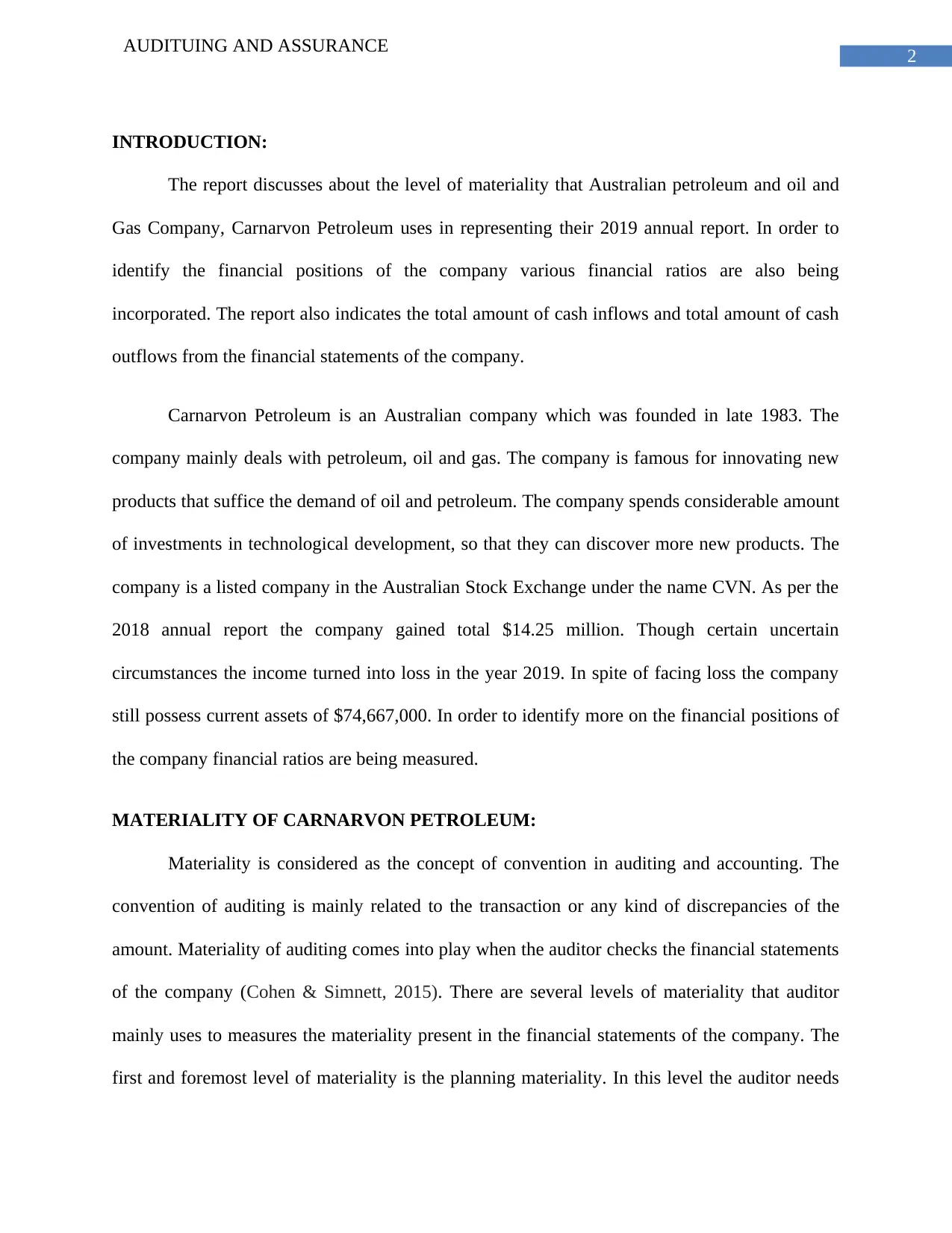
2
AUDITUING AND ASSURANCE
INTRODUCTION:
The report discusses about the level of materiality that Australian petroleum and oil and
Gas Company, Carnarvon Petroleum uses in representing their 2019 annual report. In order to
identify the financial positions of the company various financial ratios are also being
incorporated. The report also indicates the total amount of cash inflows and total amount of cash
outflows from the financial statements of the company.
Carnarvon Petroleum is an Australian company which was founded in late 1983. The
company mainly deals with petroleum, oil and gas. The company is famous for innovating new
products that suffice the demand of oil and petroleum. The company spends considerable amount
of investments in technological development, so that they can discover more new products. The
company is a listed company in the Australian Stock Exchange under the name CVN. As per the
2018 annual report the company gained total $14.25 million. Though certain uncertain
circumstances the income turned into loss in the year 2019. In spite of facing loss the company
still possess current assets of $74,667,000. In order to identify more on the financial positions of
the company financial ratios are being measured.
MATERIALITY OF CARNARVON PETROLEUM:
Materiality is considered as the concept of convention in auditing and accounting. The
convention of auditing is mainly related to the transaction or any kind of discrepancies of the
amount. Materiality of auditing comes into play when the auditor checks the financial statements
of the company (Cohen & Simnett, 2015). There are several levels of materiality that auditor
mainly uses to measures the materiality present in the financial statements of the company. The
first and foremost level of materiality is the planning materiality. In this level the auditor needs
AUDITUING AND ASSURANCE
INTRODUCTION:
The report discusses about the level of materiality that Australian petroleum and oil and
Gas Company, Carnarvon Petroleum uses in representing their 2019 annual report. In order to
identify the financial positions of the company various financial ratios are also being
incorporated. The report also indicates the total amount of cash inflows and total amount of cash
outflows from the financial statements of the company.
Carnarvon Petroleum is an Australian company which was founded in late 1983. The
company mainly deals with petroleum, oil and gas. The company is famous for innovating new
products that suffice the demand of oil and petroleum. The company spends considerable amount
of investments in technological development, so that they can discover more new products. The
company is a listed company in the Australian Stock Exchange under the name CVN. As per the
2018 annual report the company gained total $14.25 million. Though certain uncertain
circumstances the income turned into loss in the year 2019. In spite of facing loss the company
still possess current assets of $74,667,000. In order to identify more on the financial positions of
the company financial ratios are being measured.
MATERIALITY OF CARNARVON PETROLEUM:
Materiality is considered as the concept of convention in auditing and accounting. The
convention of auditing is mainly related to the transaction or any kind of discrepancies of the
amount. Materiality of auditing comes into play when the auditor checks the financial statements
of the company (Cohen & Simnett, 2015). There are several levels of materiality that auditor
mainly uses to measures the materiality present in the financial statements of the company. The
first and foremost level of materiality is the planning materiality. In this level the auditor needs
⊘ This is a preview!⊘
Do you want full access?
Subscribe today to unlock all pages.

Trusted by 1+ million students worldwide
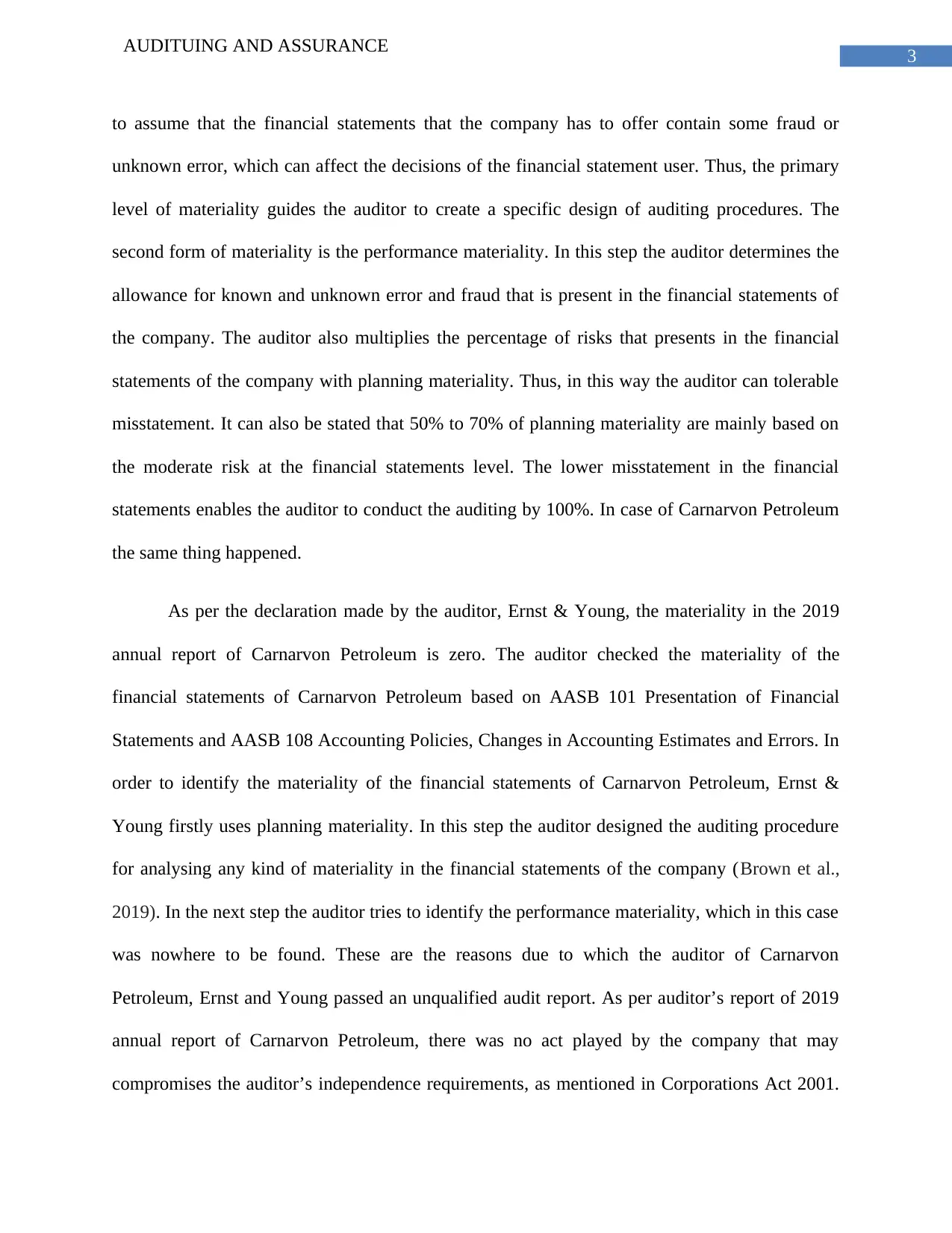
3
AUDITUING AND ASSURANCE
to assume that the financial statements that the company has to offer contain some fraud or
unknown error, which can affect the decisions of the financial statement user. Thus, the primary
level of materiality guides the auditor to create a specific design of auditing procedures. The
second form of materiality is the performance materiality. In this step the auditor determines the
allowance for known and unknown error and fraud that is present in the financial statements of
the company. The auditor also multiplies the percentage of risks that presents in the financial
statements of the company with planning materiality. Thus, in this way the auditor can tolerable
misstatement. It can also be stated that 50% to 70% of planning materiality are mainly based on
the moderate risk at the financial statements level. The lower misstatement in the financial
statements enables the auditor to conduct the auditing by 100%. In case of Carnarvon Petroleum
the same thing happened.
As per the declaration made by the auditor, Ernst & Young, the materiality in the 2019
annual report of Carnarvon Petroleum is zero. The auditor checked the materiality of the
financial statements of Carnarvon Petroleum based on AASB 101 Presentation of Financial
Statements and AASB 108 Accounting Policies, Changes in Accounting Estimates and Errors. In
order to identify the materiality of the financial statements of Carnarvon Petroleum, Ernst &
Young firstly uses planning materiality. In this step the auditor designed the auditing procedure
for analysing any kind of materiality in the financial statements of the company (Brown et al.,
2019). In the next step the auditor tries to identify the performance materiality, which in this case
was nowhere to be found. These are the reasons due to which the auditor of Carnarvon
Petroleum, Ernst and Young passed an unqualified audit report. As per auditor’s report of 2019
annual report of Carnarvon Petroleum, there was no act played by the company that may
compromises the auditor’s independence requirements, as mentioned in Corporations Act 2001.
AUDITUING AND ASSURANCE
to assume that the financial statements that the company has to offer contain some fraud or
unknown error, which can affect the decisions of the financial statement user. Thus, the primary
level of materiality guides the auditor to create a specific design of auditing procedures. The
second form of materiality is the performance materiality. In this step the auditor determines the
allowance for known and unknown error and fraud that is present in the financial statements of
the company. The auditor also multiplies the percentage of risks that presents in the financial
statements of the company with planning materiality. Thus, in this way the auditor can tolerable
misstatement. It can also be stated that 50% to 70% of planning materiality are mainly based on
the moderate risk at the financial statements level. The lower misstatement in the financial
statements enables the auditor to conduct the auditing by 100%. In case of Carnarvon Petroleum
the same thing happened.
As per the declaration made by the auditor, Ernst & Young, the materiality in the 2019
annual report of Carnarvon Petroleum is zero. The auditor checked the materiality of the
financial statements of Carnarvon Petroleum based on AASB 101 Presentation of Financial
Statements and AASB 108 Accounting Policies, Changes in Accounting Estimates and Errors. In
order to identify the materiality of the financial statements of Carnarvon Petroleum, Ernst &
Young firstly uses planning materiality. In this step the auditor designed the auditing procedure
for analysing any kind of materiality in the financial statements of the company (Brown et al.,
2019). In the next step the auditor tries to identify the performance materiality, which in this case
was nowhere to be found. These are the reasons due to which the auditor of Carnarvon
Petroleum, Ernst and Young passed an unqualified audit report. As per auditor’s report of 2019
annual report of Carnarvon Petroleum, there was no act played by the company that may
compromises the auditor’s independence requirements, as mentioned in Corporations Act 2001.
Paraphrase This Document
Need a fresh take? Get an instant paraphrase of this document with our AI Paraphraser
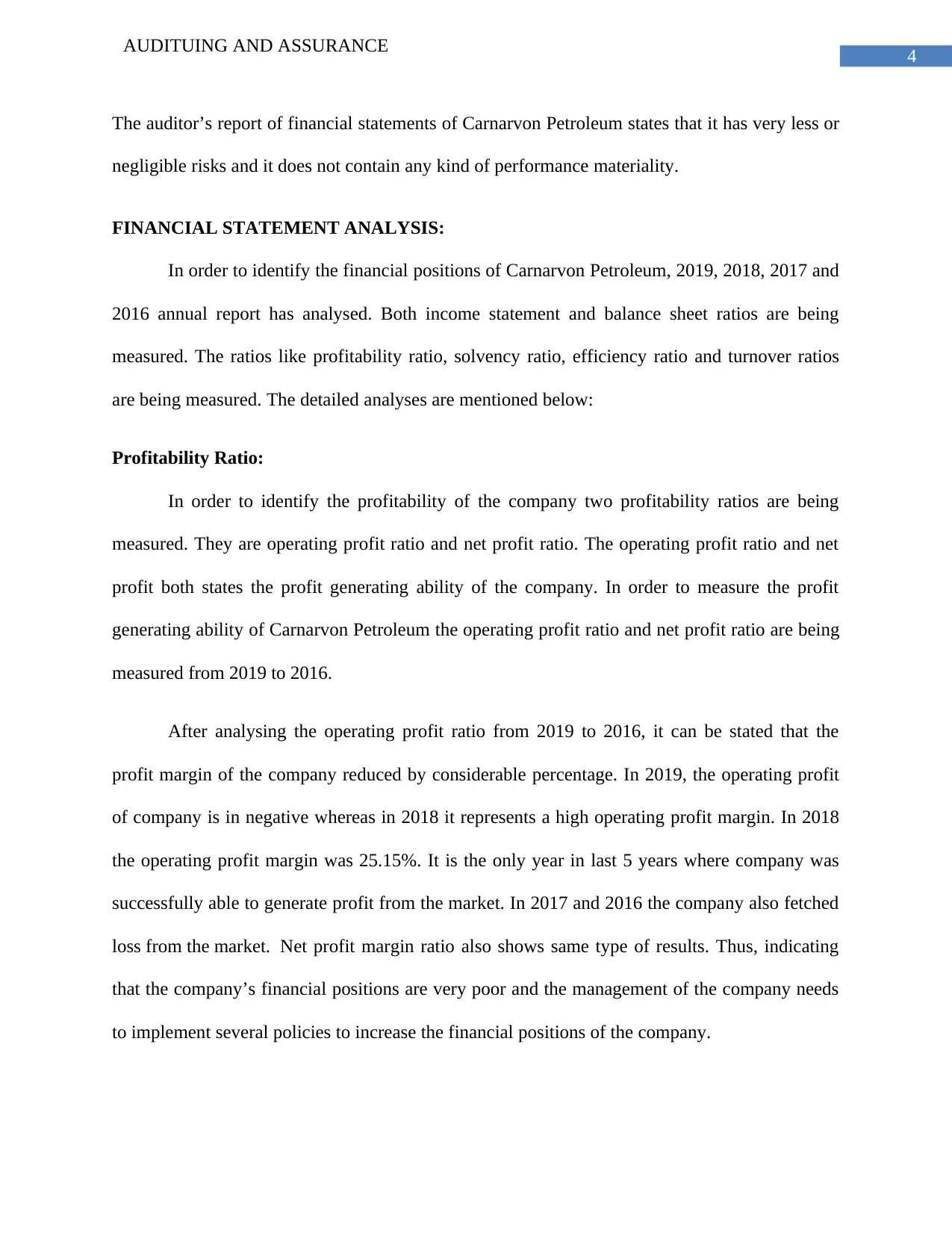
4
AUDITUING AND ASSURANCE
The auditor’s report of financial statements of Carnarvon Petroleum states that it has very less or
negligible risks and it does not contain any kind of performance materiality.
FINANCIAL STATEMENT ANALYSIS:
In order to identify the financial positions of Carnarvon Petroleum, 2019, 2018, 2017 and
2016 annual report has analysed. Both income statement and balance sheet ratios are being
measured. The ratios like profitability ratio, solvency ratio, efficiency ratio and turnover ratios
are being measured. The detailed analyses are mentioned below:
Profitability Ratio:
In order to identify the profitability of the company two profitability ratios are being
measured. They are operating profit ratio and net profit ratio. The operating profit ratio and net
profit both states the profit generating ability of the company. In order to measure the profit
generating ability of Carnarvon Petroleum the operating profit ratio and net profit ratio are being
measured from 2019 to 2016.
After analysing the operating profit ratio from 2019 to 2016, it can be stated that the
profit margin of the company reduced by considerable percentage. In 2019, the operating profit
of company is in negative whereas in 2018 it represents a high operating profit margin. In 2018
the operating profit margin was 25.15%. It is the only year in last 5 years where company was
successfully able to generate profit from the market. In 2017 and 2016 the company also fetched
loss from the market. Net profit margin ratio also shows same type of results. Thus, indicating
that the company’s financial positions are very poor and the management of the company needs
to implement several policies to increase the financial positions of the company.
AUDITUING AND ASSURANCE
The auditor’s report of financial statements of Carnarvon Petroleum states that it has very less or
negligible risks and it does not contain any kind of performance materiality.
FINANCIAL STATEMENT ANALYSIS:
In order to identify the financial positions of Carnarvon Petroleum, 2019, 2018, 2017 and
2016 annual report has analysed. Both income statement and balance sheet ratios are being
measured. The ratios like profitability ratio, solvency ratio, efficiency ratio and turnover ratios
are being measured. The detailed analyses are mentioned below:
Profitability Ratio:
In order to identify the profitability of the company two profitability ratios are being
measured. They are operating profit ratio and net profit ratio. The operating profit ratio and net
profit both states the profit generating ability of the company. In order to measure the profit
generating ability of Carnarvon Petroleum the operating profit ratio and net profit ratio are being
measured from 2019 to 2016.
After analysing the operating profit ratio from 2019 to 2016, it can be stated that the
profit margin of the company reduced by considerable percentage. In 2019, the operating profit
of company is in negative whereas in 2018 it represents a high operating profit margin. In 2018
the operating profit margin was 25.15%. It is the only year in last 5 years where company was
successfully able to generate profit from the market. In 2017 and 2016 the company also fetched
loss from the market. Net profit margin ratio also shows same type of results. Thus, indicating
that the company’s financial positions are very poor and the management of the company needs
to implement several policies to increase the financial positions of the company.
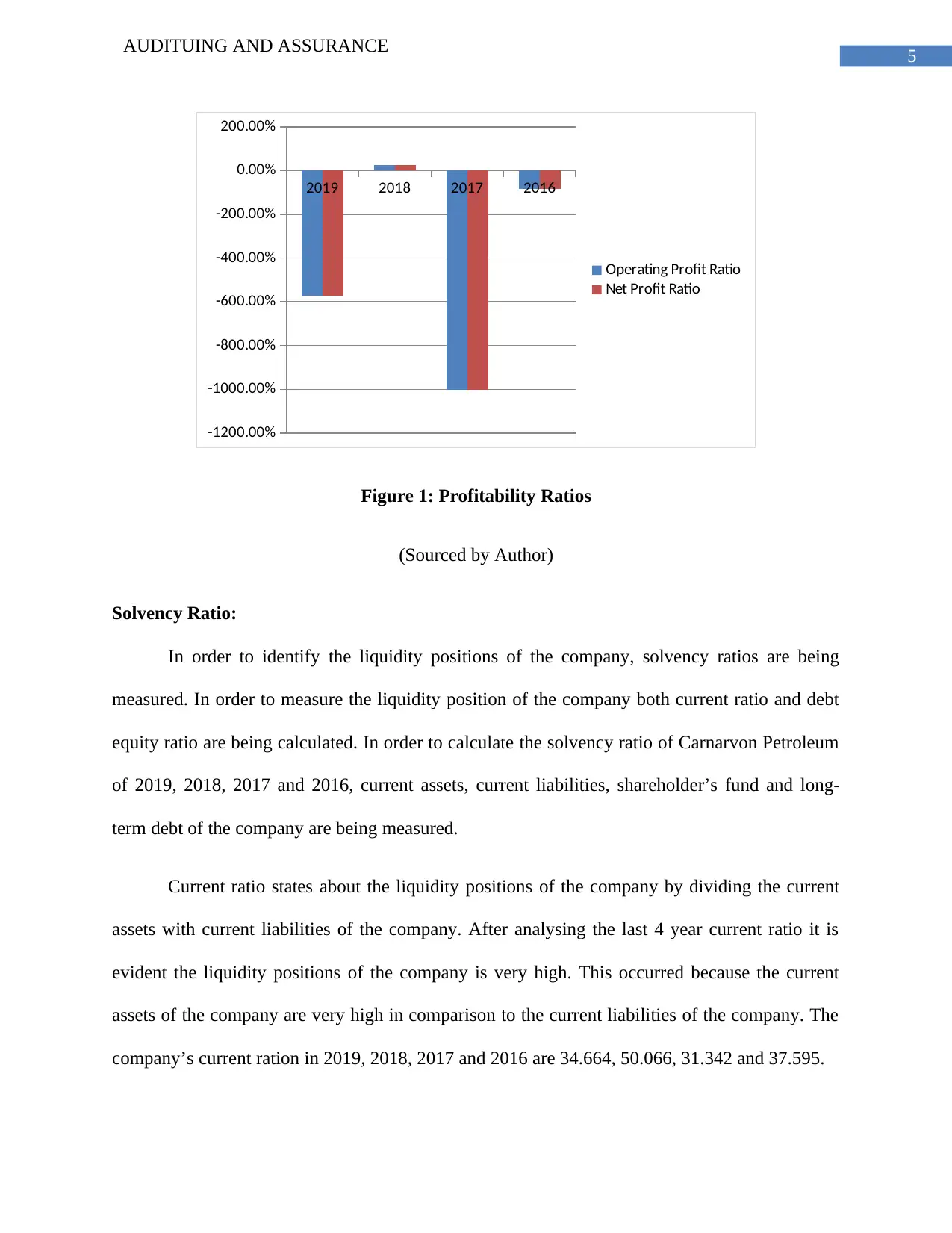
5
AUDITUING AND ASSURANCE
2019 2018 2017 2016
-1200.00%
-1000.00%
-800.00%
-600.00%
-400.00%
-200.00%
0.00%
200.00%
Operating Profit Ratio
Net Profit Ratio
Figure 1: Profitability Ratios
(Sourced by Author)
Solvency Ratio:
In order to identify the liquidity positions of the company, solvency ratios are being
measured. In order to measure the liquidity position of the company both current ratio and debt
equity ratio are being calculated. In order to calculate the solvency ratio of Carnarvon Petroleum
of 2019, 2018, 2017 and 2016, current assets, current liabilities, shareholder’s fund and long-
term debt of the company are being measured.
Current ratio states about the liquidity positions of the company by dividing the current
assets with current liabilities of the company. After analysing the last 4 year current ratio it is
evident the liquidity positions of the company is very high. This occurred because the current
assets of the company are very high in comparison to the current liabilities of the company. The
company’s current ration in 2019, 2018, 2017 and 2016 are 34.664, 50.066, 31.342 and 37.595.
AUDITUING AND ASSURANCE
2019 2018 2017 2016
-1200.00%
-1000.00%
-800.00%
-600.00%
-400.00%
-200.00%
0.00%
200.00%
Operating Profit Ratio
Net Profit Ratio
Figure 1: Profitability Ratios
(Sourced by Author)
Solvency Ratio:
In order to identify the liquidity positions of the company, solvency ratios are being
measured. In order to measure the liquidity position of the company both current ratio and debt
equity ratio are being calculated. In order to calculate the solvency ratio of Carnarvon Petroleum
of 2019, 2018, 2017 and 2016, current assets, current liabilities, shareholder’s fund and long-
term debt of the company are being measured.
Current ratio states about the liquidity positions of the company by dividing the current
assets with current liabilities of the company. After analysing the last 4 year current ratio it is
evident the liquidity positions of the company is very high. This occurred because the current
assets of the company are very high in comparison to the current liabilities of the company. The
company’s current ration in 2019, 2018, 2017 and 2016 are 34.664, 50.066, 31.342 and 37.595.
⊘ This is a preview!⊘
Do you want full access?
Subscribe today to unlock all pages.

Trusted by 1+ million students worldwide

6
AUDITUING AND ASSURANCE
2019 2018 2017 2016
-1200.00%
-1000.00%
-800.00%
-600.00%
-400.00%
-200.00%
0.00%
200.00%
Operating Profit Ratio
Net Profit Ratio
Figure 2: Current Ratio
(Sourced by Author)
On the other hand, debt equity ratio of the solvency ratio states about the financial
leverage of the company. As per the analysis of the financial leverage of Carnarvon Petroleum, it
can be determined that the results are below average as it showcases amount which are below
0.0. This means that the company’s shareholder’s equity is not sufficient to meet the debt of the
company.
AUDITUING AND ASSURANCE
2019 2018 2017 2016
-1200.00%
-1000.00%
-800.00%
-600.00%
-400.00%
-200.00%
0.00%
200.00%
Operating Profit Ratio
Net Profit Ratio
Figure 2: Current Ratio
(Sourced by Author)
On the other hand, debt equity ratio of the solvency ratio states about the financial
leverage of the company. As per the analysis of the financial leverage of Carnarvon Petroleum, it
can be determined that the results are below average as it showcases amount which are below
0.0. This means that the company’s shareholder’s equity is not sufficient to meet the debt of the
company.
Paraphrase This Document
Need a fresh take? Get an instant paraphrase of this document with our AI Paraphraser
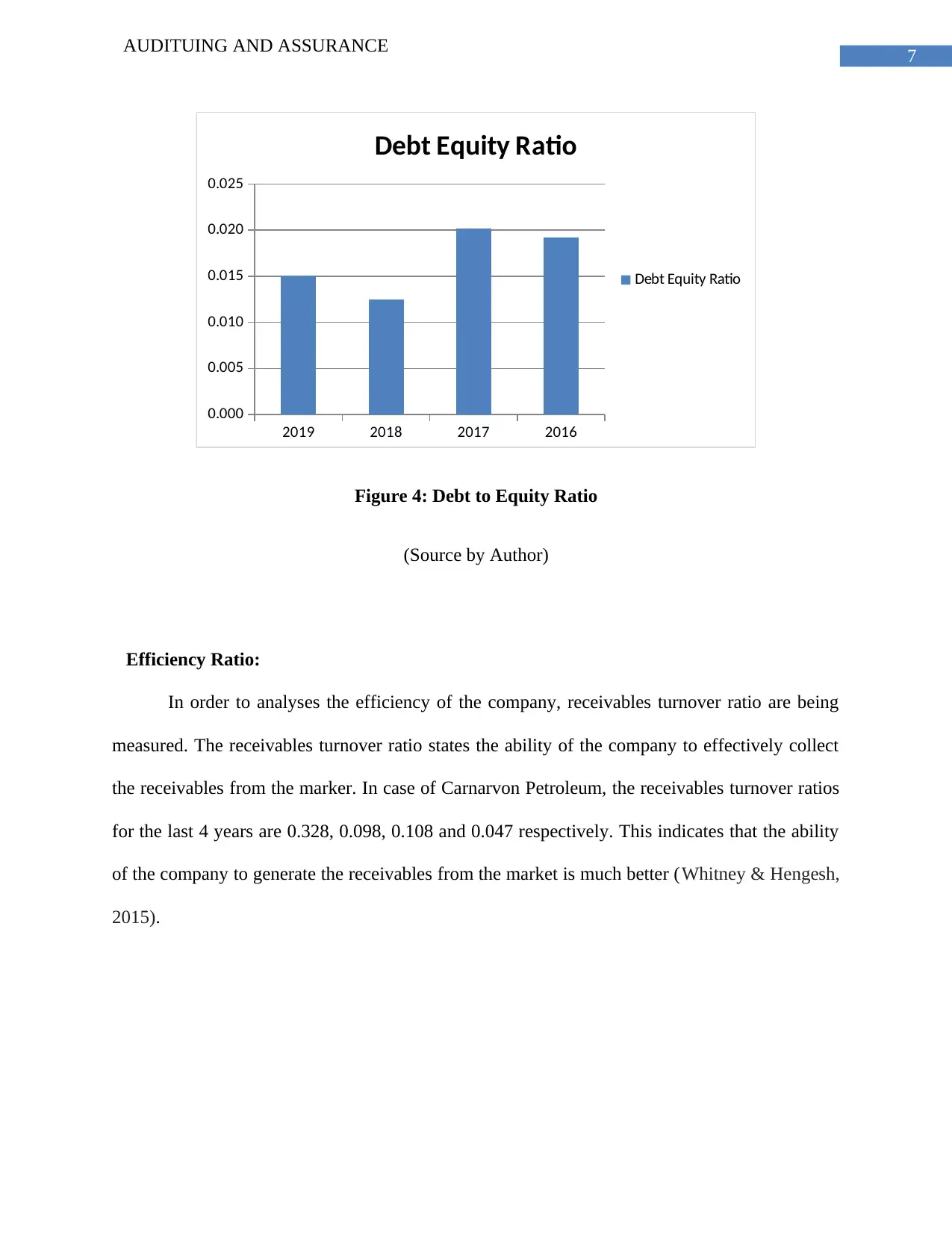
7
AUDITUING AND ASSURANCE
2019 2018 2017 2016
0.000
0.005
0.010
0.015
0.020
0.025
Debt Equity Ratio
Debt Equity Ratio
Figure 4: Debt to Equity Ratio
(Source by Author)
Efficiency Ratio:
In order to analyses the efficiency of the company, receivables turnover ratio are being
measured. The receivables turnover ratio states the ability of the company to effectively collect
the receivables from the marker. In case of Carnarvon Petroleum, the receivables turnover ratios
for the last 4 years are 0.328, 0.098, 0.108 and 0.047 respectively. This indicates that the ability
of the company to generate the receivables from the market is much better (Whitney & Hengesh,
2015).
AUDITUING AND ASSURANCE
2019 2018 2017 2016
0.000
0.005
0.010
0.015
0.020
0.025
Debt Equity Ratio
Debt Equity Ratio
Figure 4: Debt to Equity Ratio
(Source by Author)
Efficiency Ratio:
In order to analyses the efficiency of the company, receivables turnover ratio are being
measured. The receivables turnover ratio states the ability of the company to effectively collect
the receivables from the marker. In case of Carnarvon Petroleum, the receivables turnover ratios
for the last 4 years are 0.328, 0.098, 0.108 and 0.047 respectively. This indicates that the ability
of the company to generate the receivables from the market is much better (Whitney & Hengesh,
2015).
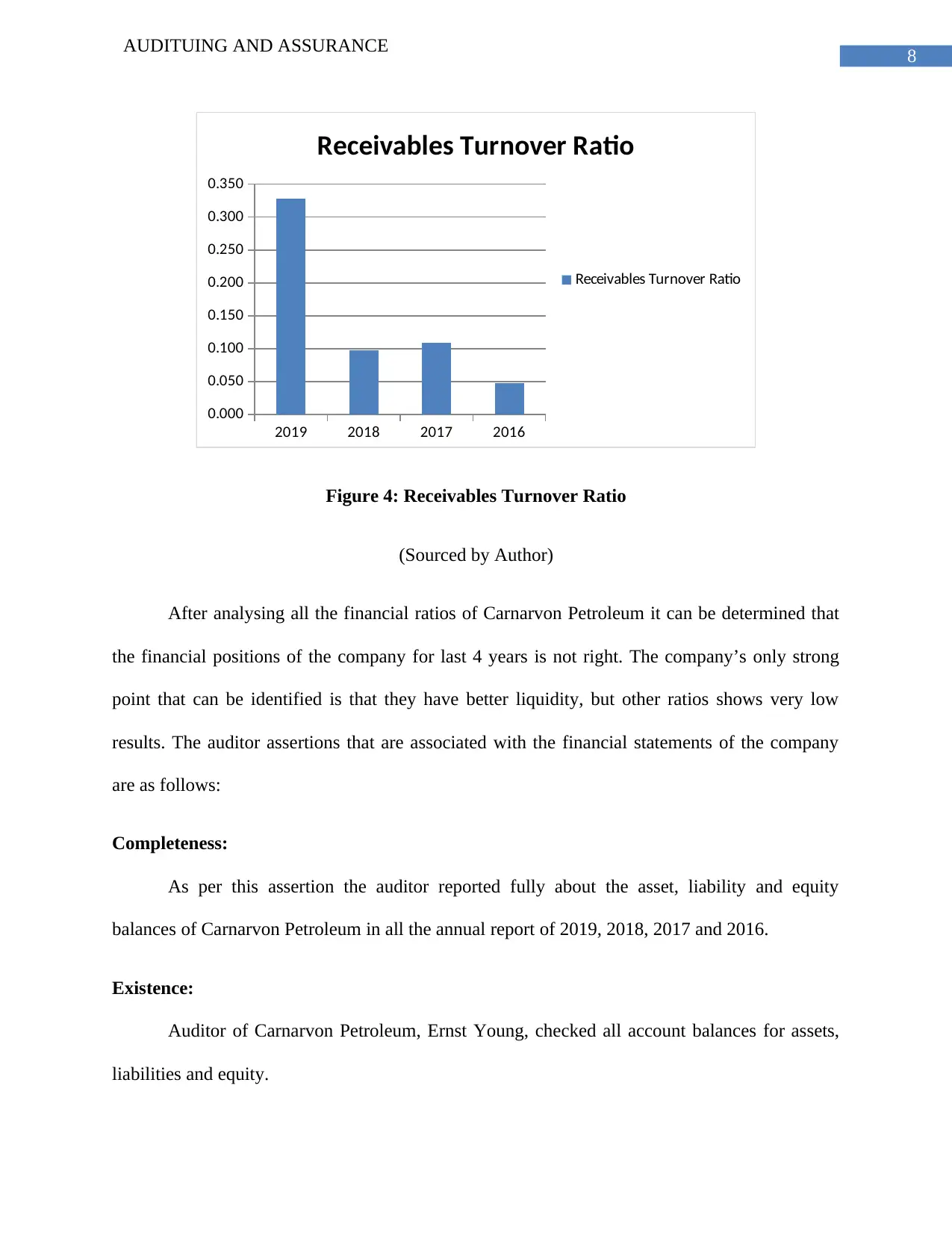
8
AUDITUING AND ASSURANCE
2019 2018 2017 2016
0.000
0.050
0.100
0.150
0.200
0.250
0.300
0.350
Receivables Turnover Ratio
Receivables Turnover Ratio
Figure 4: Receivables Turnover Ratio
(Sourced by Author)
After analysing all the financial ratios of Carnarvon Petroleum it can be determined that
the financial positions of the company for last 4 years is not right. The company’s only strong
point that can be identified is that they have better liquidity, but other ratios shows very low
results. The auditor assertions that are associated with the financial statements of the company
are as follows:
Completeness:
As per this assertion the auditor reported fully about the asset, liability and equity
balances of Carnarvon Petroleum in all the annual report of 2019, 2018, 2017 and 2016.
Existence:
Auditor of Carnarvon Petroleum, Ernst Young, checked all account balances for assets,
liabilities and equity.
AUDITUING AND ASSURANCE
2019 2018 2017 2016
0.000
0.050
0.100
0.150
0.200
0.250
0.300
0.350
Receivables Turnover Ratio
Receivables Turnover Ratio
Figure 4: Receivables Turnover Ratio
(Sourced by Author)
After analysing all the financial ratios of Carnarvon Petroleum it can be determined that
the financial positions of the company for last 4 years is not right. The company’s only strong
point that can be identified is that they have better liquidity, but other ratios shows very low
results. The auditor assertions that are associated with the financial statements of the company
are as follows:
Completeness:
As per this assertion the auditor reported fully about the asset, liability and equity
balances of Carnarvon Petroleum in all the annual report of 2019, 2018, 2017 and 2016.
Existence:
Auditor of Carnarvon Petroleum, Ernst Young, checked all account balances for assets,
liabilities and equity.
⊘ This is a preview!⊘
Do you want full access?
Subscribe today to unlock all pages.

Trusted by 1+ million students worldwide
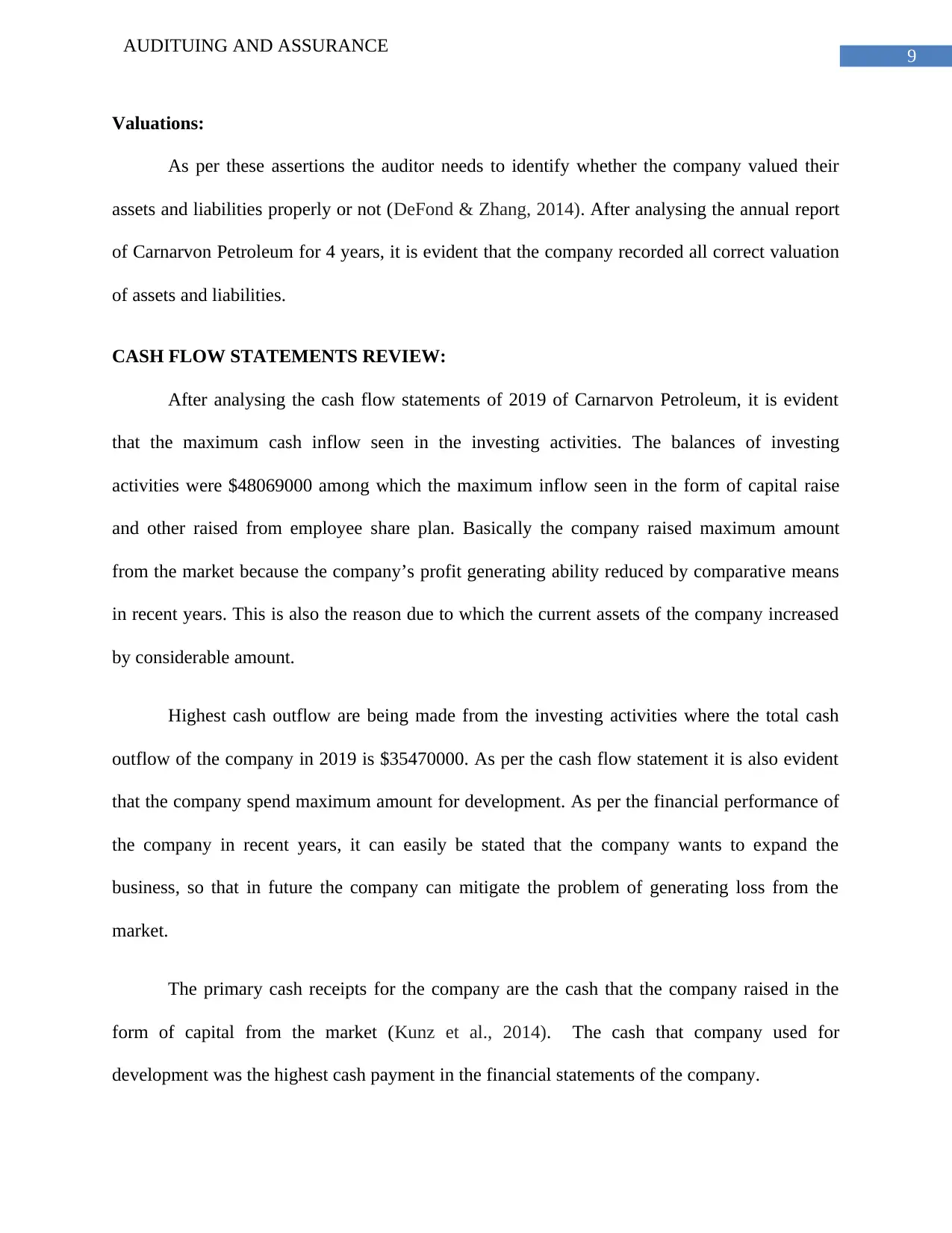
9
AUDITUING AND ASSURANCE
Valuations:
As per these assertions the auditor needs to identify whether the company valued their
assets and liabilities properly or not (DeFond & Zhang, 2014). After analysing the annual report
of Carnarvon Petroleum for 4 years, it is evident that the company recorded all correct valuation
of assets and liabilities.
CASH FLOW STATEMENTS REVIEW:
After analysing the cash flow statements of 2019 of Carnarvon Petroleum, it is evident
that the maximum cash inflow seen in the investing activities. The balances of investing
activities were $48069000 among which the maximum inflow seen in the form of capital raise
and other raised from employee share plan. Basically the company raised maximum amount
from the market because the company’s profit generating ability reduced by comparative means
in recent years. This is also the reason due to which the current assets of the company increased
by considerable amount.
Highest cash outflow are being made from the investing activities where the total cash
outflow of the company in 2019 is $35470000. As per the cash flow statement it is also evident
that the company spend maximum amount for development. As per the financial performance of
the company in recent years, it can easily be stated that the company wants to expand the
business, so that in future the company can mitigate the problem of generating loss from the
market.
The primary cash receipts for the company are the cash that the company raised in the
form of capital from the market (Kunz et al., 2014). The cash that company used for
development was the highest cash payment in the financial statements of the company.
AUDITUING AND ASSURANCE
Valuations:
As per these assertions the auditor needs to identify whether the company valued their
assets and liabilities properly or not (DeFond & Zhang, 2014). After analysing the annual report
of Carnarvon Petroleum for 4 years, it is evident that the company recorded all correct valuation
of assets and liabilities.
CASH FLOW STATEMENTS REVIEW:
After analysing the cash flow statements of 2019 of Carnarvon Petroleum, it is evident
that the maximum cash inflow seen in the investing activities. The balances of investing
activities were $48069000 among which the maximum inflow seen in the form of capital raise
and other raised from employee share plan. Basically the company raised maximum amount
from the market because the company’s profit generating ability reduced by comparative means
in recent years. This is also the reason due to which the current assets of the company increased
by considerable amount.
Highest cash outflow are being made from the investing activities where the total cash
outflow of the company in 2019 is $35470000. As per the cash flow statement it is also evident
that the company spend maximum amount for development. As per the financial performance of
the company in recent years, it can easily be stated that the company wants to expand the
business, so that in future the company can mitigate the problem of generating loss from the
market.
The primary cash receipts for the company are the cash that the company raised in the
form of capital from the market (Kunz et al., 2014). The cash that company used for
development was the highest cash payment in the financial statements of the company.
Paraphrase This Document
Need a fresh take? Get an instant paraphrase of this document with our AI Paraphraser
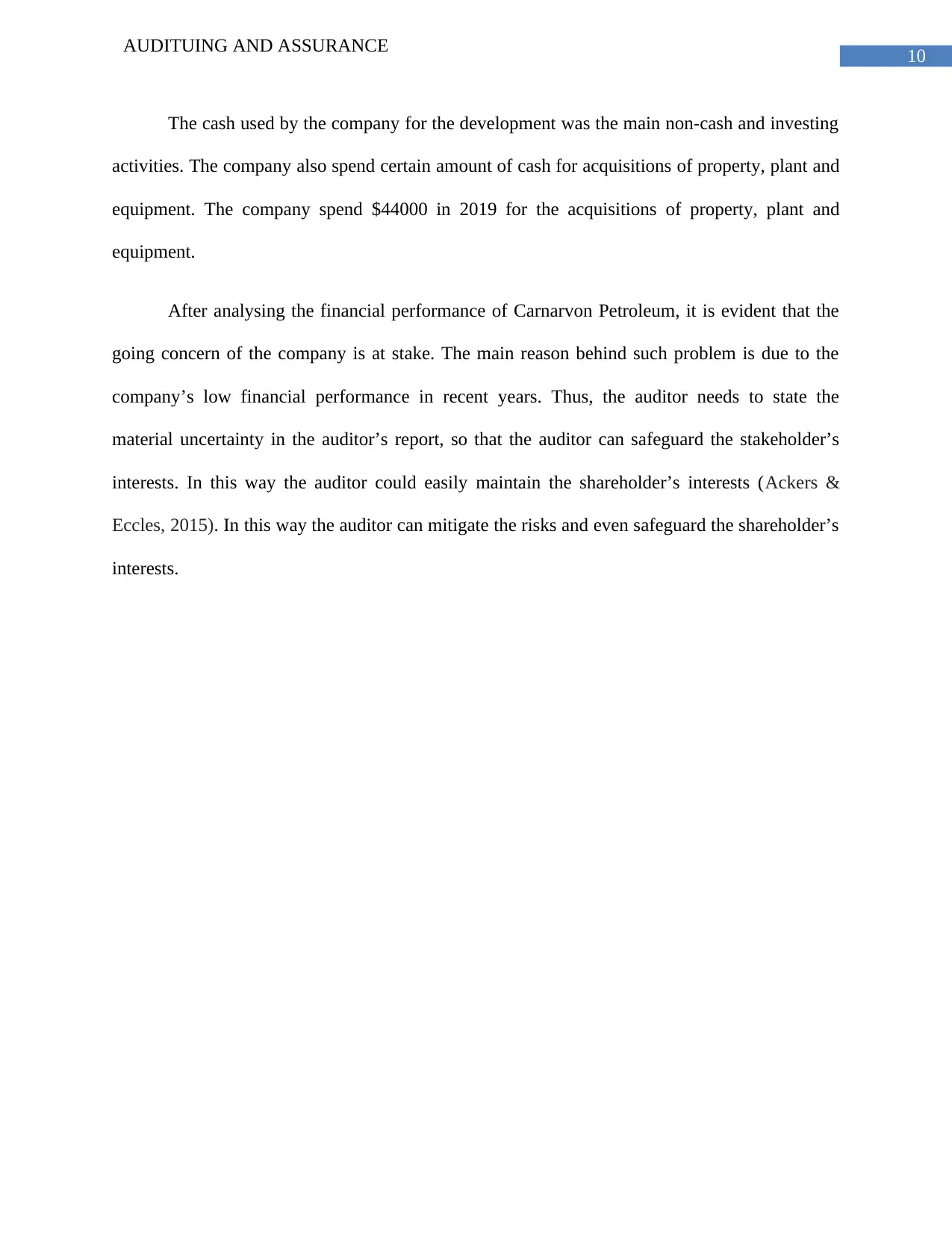
10
AUDITUING AND ASSURANCE
The cash used by the company for the development was the main non-cash and investing
activities. The company also spend certain amount of cash for acquisitions of property, plant and
equipment. The company spend $44000 in 2019 for the acquisitions of property, plant and
equipment.
After analysing the financial performance of Carnarvon Petroleum, it is evident that the
going concern of the company is at stake. The main reason behind such problem is due to the
company’s low financial performance in recent years. Thus, the auditor needs to state the
material uncertainty in the auditor’s report, so that the auditor can safeguard the stakeholder’s
interests. In this way the auditor could easily maintain the shareholder’s interests (Ackers &
Eccles, 2015). In this way the auditor can mitigate the risks and even safeguard the shareholder’s
interests.
AUDITUING AND ASSURANCE
The cash used by the company for the development was the main non-cash and investing
activities. The company also spend certain amount of cash for acquisitions of property, plant and
equipment. The company spend $44000 in 2019 for the acquisitions of property, plant and
equipment.
After analysing the financial performance of Carnarvon Petroleum, it is evident that the
going concern of the company is at stake. The main reason behind such problem is due to the
company’s low financial performance in recent years. Thus, the auditor needs to state the
material uncertainty in the auditor’s report, so that the auditor can safeguard the stakeholder’s
interests. In this way the auditor could easily maintain the shareholder’s interests (Ackers &
Eccles, 2015). In this way the auditor can mitigate the risks and even safeguard the shareholder’s
interests.
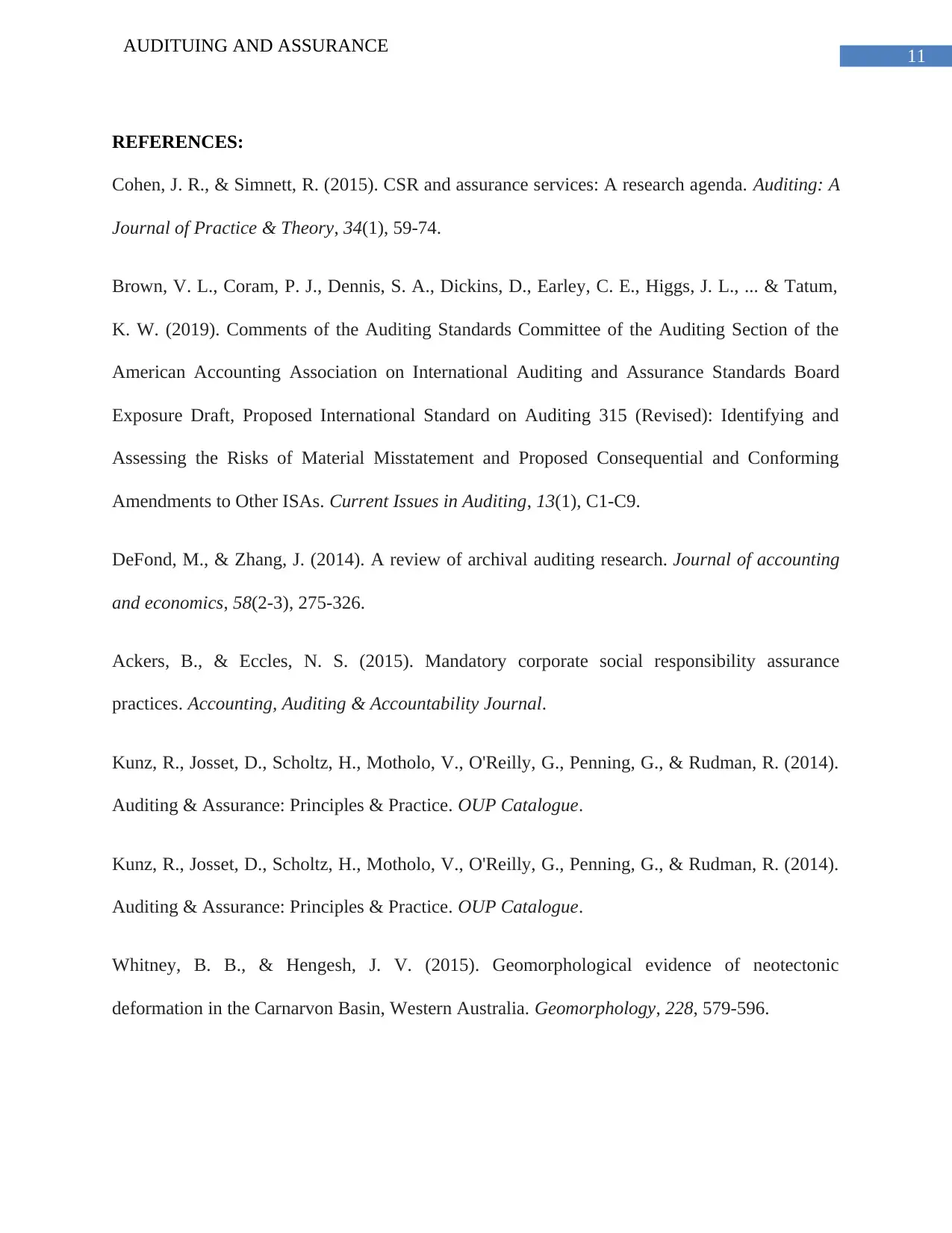
11
AUDITUING AND ASSURANCE
REFERENCES:
Cohen, J. R., & Simnett, R. (2015). CSR and assurance services: A research agenda. Auditing: A
Journal of Practice & Theory, 34(1), 59-74.
Brown, V. L., Coram, P. J., Dennis, S. A., Dickins, D., Earley, C. E., Higgs, J. L., ... & Tatum,
K. W. (2019). Comments of the Auditing Standards Committee of the Auditing Section of the
American Accounting Association on International Auditing and Assurance Standards Board
Exposure Draft, Proposed International Standard on Auditing 315 (Revised): Identifying and
Assessing the Risks of Material Misstatement and Proposed Consequential and Conforming
Amendments to Other ISAs. Current Issues in Auditing, 13(1), C1-C9.
DeFond, M., & Zhang, J. (2014). A review of archival auditing research. Journal of accounting
and economics, 58(2-3), 275-326.
Ackers, B., & Eccles, N. S. (2015). Mandatory corporate social responsibility assurance
practices. Accounting, Auditing & Accountability Journal.
Kunz, R., Josset, D., Scholtz, H., Motholo, V., O'Reilly, G., Penning, G., & Rudman, R. (2014).
Auditing & Assurance: Principles & Practice. OUP Catalogue.
Kunz, R., Josset, D., Scholtz, H., Motholo, V., O'Reilly, G., Penning, G., & Rudman, R. (2014).
Auditing & Assurance: Principles & Practice. OUP Catalogue.
Whitney, B. B., & Hengesh, J. V. (2015). Geomorphological evidence of neotectonic
deformation in the Carnarvon Basin, Western Australia. Geomorphology, 228, 579-596.
AUDITUING AND ASSURANCE
REFERENCES:
Cohen, J. R., & Simnett, R. (2015). CSR and assurance services: A research agenda. Auditing: A
Journal of Practice & Theory, 34(1), 59-74.
Brown, V. L., Coram, P. J., Dennis, S. A., Dickins, D., Earley, C. E., Higgs, J. L., ... & Tatum,
K. W. (2019). Comments of the Auditing Standards Committee of the Auditing Section of the
American Accounting Association on International Auditing and Assurance Standards Board
Exposure Draft, Proposed International Standard on Auditing 315 (Revised): Identifying and
Assessing the Risks of Material Misstatement and Proposed Consequential and Conforming
Amendments to Other ISAs. Current Issues in Auditing, 13(1), C1-C9.
DeFond, M., & Zhang, J. (2014). A review of archival auditing research. Journal of accounting
and economics, 58(2-3), 275-326.
Ackers, B., & Eccles, N. S. (2015). Mandatory corporate social responsibility assurance
practices. Accounting, Auditing & Accountability Journal.
Kunz, R., Josset, D., Scholtz, H., Motholo, V., O'Reilly, G., Penning, G., & Rudman, R. (2014).
Auditing & Assurance: Principles & Practice. OUP Catalogue.
Kunz, R., Josset, D., Scholtz, H., Motholo, V., O'Reilly, G., Penning, G., & Rudman, R. (2014).
Auditing & Assurance: Principles & Practice. OUP Catalogue.
Whitney, B. B., & Hengesh, J. V. (2015). Geomorphological evidence of neotectonic
deformation in the Carnarvon Basin, Western Australia. Geomorphology, 228, 579-596.
⊘ This is a preview!⊘
Do you want full access?
Subscribe today to unlock all pages.

Trusted by 1+ million students worldwide
1 out of 13
Related Documents
Your All-in-One AI-Powered Toolkit for Academic Success.
+13062052269
info@desklib.com
Available 24*7 on WhatsApp / Email
![[object Object]](/_next/static/media/star-bottom.7253800d.svg)
Unlock your academic potential
Copyright © 2020–2025 A2Z Services. All Rights Reserved. Developed and managed by ZUCOL.





